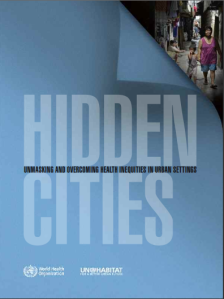“The World Health Organization (WHO) and United Nations Human Settlements Programme (UN-HABITAT) joint global report, Hidden cities, exposes the extent to which certain city dwellers suffer disproportionately from a wide range of diseases and health problems.
While urban living continues to offer many opportunities, these advantages can be extremely uneven in their distribution. While it is generally understood that city dwellers on average, enjoy better health than their rural counterparts, very little is known about health differences that exist within cities. No city is immune to this problem. The list of potential urban hazards include substandard housing and crowded living conditions, problems with food and water safety, inadequate sanitation and solid waste disposal services, air pollution, and congested traffic, etc.
Many cities face a triple threat: infectious diseases thrive when people are crowded together under paltry living conditions. Chronic, non communicable diseases are on the rise with the globalization of unhealthy lifestyles, which are facilitated by urban life – tobacco use, unhealthy diets, physical inactivity and harmful use of alcohol. And urban health is further burdened by accidents, injuries, road accidents, violence, and crime.
Urbanization, both in the developing and developed world, has been accompanied by a concentration of poverty which is becoming a severe, pervasive, and largely unacknowledged feature of urban life. This is accompanied by lack of adequate capacity of Municipal bodies to extend services to the urban poor.
The health sector cannot act alone to tackle those inequities and the various urban health challenges. Opportunities to put health at the heart of the urban policy agenda exist, and it is time for all sectors to work together toward innovative and effective solutions that mitigate health risks and increase health benefits.
This report provides information and tools to help governments and local leaders reduce health inequities in their cities.”
PDF:http://www.hiddencities.org/downloads/WHO_UN-HABITAT_Hidden_Cities_Web.pdf (145 pages, 3.30 MB)

